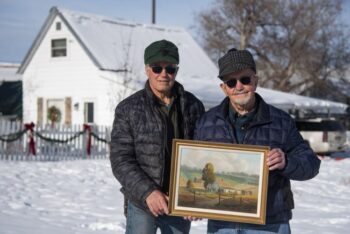By
On a sunny Wednesday morning, when frost was starting to drip off hay bales and bare pavement peaked through snow on Norris Road, a farming family who has called this land home for over a century gathered to discuss their history.
The Todd family has farmed west of Four Corners since the early 1900s. The grandkids who live there today are sixth-generation Montanans. The wooden sign near the mailbox inscribed with “Jerlay Farms” showed the history of the homestead: “Jer” for the jersey dairy cows and “Lay” for the leghorn chickens once raised here.
While the farm has changed over the years, preserving the rich agricultural heritage was one reason the family wanted to do a conservation easement.

Jeff Todd and his father, Milo.
The Todds completed a conservation easement with Montana Land Reliance in December, adding 146 acres to the “growing neighborhood of conservation” west of Four Corners. They joined their neighbors to the north and west in conserving their land.
The area, like much of undeveloped Gallatin Valley, is a conservation priority because of the water resources, wildlife habitat and deep, fertile topsoil that is renowned as some of the best agricultural land in the country.
When a landowner creates a conservation easement, they are essentially donating the development value of the property. That’s not always financially feasible, which is why programs like Gallatin County Open Lands and the Natural Resources Conservation Service sometimes help fund conservation projects.
Land trusts then monitor easements “in perpetuity” to make sure they remain undeveloped. Even if the land is sold, the easement remains.
“That’s the beauty of it — people can protect their family legacy and the land they love so much that’s been in their family for generations, and have it stay as it is,” said Kathryn Kelly, the Greater Yellowstone manager for Montana Land Reliance.
Milo Todd, now 93, was born on the farm that his grandfather homesteaded. The land grew grain and eventually was home to a small dairy herd. Milo Todd and his late wife, Carol, ran the dairy with their son Jeff and his wife, Kimberly, for two decades. The herd was eventually sold.
In 2002, the family began leasing ground to neighbors. The farm income was still able to support his parents, but Jeff Todd and his wife took jobs in town off the farm.
This fall marked the first time the younger Todd returned to the farm full time to complete the conservation easement and finalize a future vision for the property.
In deciding whether to do the easement, the family turned to the younger generation.
“They were in agreement that they would like to keep the lion’s share of the farm all in one piece and never see it split up,” Jeff Todd said. “Because of the value of this farm ground right here, it’s really rewarding for us to know that this land will always stay in agriculture.”
He imagined that his grandchildren, while perhaps not able to make a full living off the farm, could do something creative with the land like host equine programs or grow high-value crops like garlic.
His wife, Kimberly, said the difficulty of keeping farms profitable is the main reason farmers sell land that ends up getting developed. That’s what happened to her family’s farm she grew up on in eastern Montana.
“It’s really hard to keep farms in the family. It’s hard to make money. Jeff and I have both worked off the farm most of our lives, because the farm can’t generate enough money to support a family,” Kimberly Todd said. “So it’s a tremendous sacrifice to keep the farm going.”
Keeping the land in agriculture with the conservation easement is a gift to both future family and the Gallatin community, Jeff Todd said. Scenic views will remain open for people driving down Norris Road, and the land will continue to support countless whitetail and mule deer, elk, songbirds and owls who call it home.
Milo Todd has lived on the farm his whole life and recalled the many changes he’s seen over the decades.
He built many of the old dairy buildings now being taken down, and remembered when crews came to extend and elevate the road that the farm borders. The workers said they would need to tear out generations-old apple trees to do the work — but fortunately some were salvaged and remain there today.
Milo Todd remembered when Bozeman’s Main Street ended at the Lewis and Clark Motel and the dirt road instantly turned to hayfields.
Last summer, he took a hot air balloon ride above Gallatin Valley and got a 360-degree view of how much things have changed.
He recalled thinking, “Okay, here’s a nice field of grain. Here’s a whole field of houses. And here’s another field of houses — again,” Milo Todd said. “I guess, to an old timer, it’s kind of hard to see that happening.”
MLR’s Kelly said people seeing so much historic agricultural land turned to subdivisions is a big driver for conservation easements. She grew up farming in the Gallatin Valley too and has a special connection to this project — Milo and Carol Todd were the former leaders of her 4-H program.
“With the tremendous development pressure that we’ve had here… there becomes a sense of urgency with landowners, in that they decide they need to do something proactively to protect their land,” Kelly said.
“Because if they passed on or had to sell, for instance, in all likelihood, the land would be developed. It would no longer be a farm or ranch.”